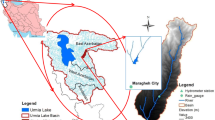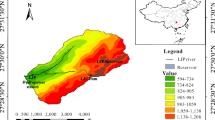Abstract
As an important measure used to balance the trade-offs of industrial, domestic, and ecological water use sectors, the low-impact optimal operation model of the cascade sluice-reservoir system (CSRS) has developed into an international concern. Limited by insufficient water storage and a deteriorating ecological environment, the actual operation ability (AOA) deviates from the originally planned ability and cannot function effectively as expected. However, the focus on the quantification of the AOA of the CSRS and its applications in water resources allocation have not received sufficient attention. This paper first constructed a multi-indicator evaluation system of the AOA consisting of water quantity, water quality, water ecology, engineering, and socioeconomic elements. Second, based on the quantified AOA, a multi-objective optimal operation model of the CSRS was proposed to lower water deficiency and pollutant loads and to reduce the negative impact on the social economy, water ecology and environment. The Shaying River basin (SRB), a human-altered basin with fierce water use competition, was selected as the study area. The results indicate that (1) the elements of water quality and water ecology are the main factors limiting the AOA. Moreover, the evaluation system is able to accurately demonstrate the evolution of the water management policies. (2) The low-impact optimal operation scheme has a stronger superiority with less water shortages in both city units and ecology, especially when the inflow is less and the benefits of agricultural, industrial and domestic water use are prioritized. The model contributes to the knowledge of water-society-ecology trade-offs.



Similar content being viewed by others
Data Availability
Will be available after request from the corresponding author.
Code Availability
Codes that support the findings of this study are available after request from the corresponding author.
References
Chakraei I, Safavi HR, Dandy GC, Golmohammadi MH (2021) Integrated simulation-optimization framework for water allocation based on sustainability of surface water and groundwater resources. J Water Resour Plan Manag 147(3):05021001. https://doi.org/10.1061/(ASCE)WR.1943-5452.0001339
Cook C, Bakker K (2012) Water security: Debating an emerging paradigm. Glob Environ Chang 22(1):94–102. https://doi.org/10.1016/j.gloenvcha.2011.10.011
Deb K, Pratap A, Agarwal S, Meyarivan T (2002) A fast and elitist multiobjective genetic algorithm: NSGA-II. IEEE Trans Evol Comput 6(2):182–197. https://doi.org/10.1109/4235.996017
Di Y, Zhang Y, Liu J, Gao S, Song X (2015) Water quantity and quality joint-operation modeling of dams and floodgates in Huai River Basin, China. J Water Resour Plan Manag 141(9):04015005. https://doi.org/10.1061/(ASCE)WR.1943-5452.0000516
Ding Z, Fang G, Wen X, Tan Q, Huang X, Lei X, Tian Y, Quan J (2018) A novel operation chart for cascade hydropower system to alleviate ecological degradation in hydrological extremes. Ecol Model 384:10–22. https://doi.org/10.1016/j.ecolmodel.2018.05.025
Dou M, Zhang Y, Li G (2016) Temporal and spatial characteristics of the water pollutant concentration in Huaihe River Basin from 2003 to 2012, China. Environ Monit Assess 188(9). https://doi.org/10.1007/s10661-016-5503-0
Ganassin MJM, Muñoz-Mas R, de Oliveira FJM, Muniz CM, Dos Santos NCL, García-Berthou E, Gomes LC (2021) Effects of reservoir cascades on diversity, distribution, and abundance of fish assemblages in three Neotropical basins. Sci Total Environ 778:146246. https://doi.org/10.1016/j.scitotenv.2021.146246
HabibiDavijani M, Banihabib ME, NadjafzadehAnvar A, Hashemi SR (2016) Multi-objective optimization model for the allocation of water resources in arid regions based on the maximization of socioeconomic efficiency. Water Resour Manag 30(3):927–946. https://doi.org/10.1007/s11269-015-1200-y
Kuriqi A, Pinheiro AN, Sordo-Ward A, Garrote L (2019) Flow regime aspects in determining environmental flows and maximising energy production at run-of-river hydropower plants. Appl Energy 256:113980. https://doi.org/10.1016/j.apenergy.2019.113980
Li R, Chen Q, Tonina D, Cai D (2015) Effects of upstream reservoir regulation on the hydrological regime and fish habitats of the Lijiang River, China. Ecol Eng 76:75–83. https://doi.org/10.1016/j.ecoleng.2014.04.021
Li J, Qiao Y, Lei X, Kang A, Wang M, Liao W, Wang H, Ma Y (2019) A two-stage water allocation strategy for developing regional economic-environment sustainability. J Environ Manag 244:189–198. https://doi.org/10.1016/j.jenvman.2019.02.108
Li Q, Meng XX, Liu YB, Pang LF (2019b) Risk assessment of floor water inrush using entropy weight and variation coefficient model. Geotech Geol Eng 37(3):1493–1501. https://doi.org/10.1007/s10706-018-0702-9
Li J, Huang J, Liang P, Lund JR (2021) Fuzzy representation of environmental flow in multi-objective risk analysis of reservoir operation. Water Resour Manag 35(9):2845–2861
Liu P, Li L, Guo S, Xiong L, Zhang W, Zhang J, Xu C (2015) Optimal design of seasonal flood limited water levels and its application for the Three Gorges Reservoir. J Hydrol 527:1045–1053. https://doi.org/10.1016/j.jhydrol.2015.05.055
Luo Z, Zuo Q, Shao Q (2018) A new framework for assessing river ecosystem health with consideration of human service demand. Sci Total Environ 640–641:442–453. https://doi.org/10.1016/j.scitotenv.2018.05.361
Mooselu MG, Nikoo MR, Latifi M, Sadegh M, Al-Wardy M, Al-Rawas GA (2020) A multi-objective optimal allocation of treated wastewater in urban areas using leader-follower game. J Clean Prod 267:122189. https://doi.org/10.1016/j.jclepro.2020.122189
Nguyen LD, Tran DQ (2021) Measurement of fuzzy membership functions in construction risk assessment. J Constr Eng Manag 147(4):04021005. https://doi.org/10.1061/(ASCE)CO.1943-7862.0002015
Oki T, Kanae S (2006) Global hydrological cycles and world water resources. Science 313(5790):1068–1072. https://doi.org/10.1126/science.1128845
Shan B, Guo S, Wang Y, Li H, Guo P (2021) Vine copula and cloud model-based programming approach for agricultural water allocation under uncertainty. Stoch Environ Res Risk Assess. https://doi.org/10.1007/s00477-021-01985-3
Steinschneider S, Bernstein A, Palmer R, Polebitski A (2014) Reservoir management optimization for basin-wide ecological restoration in the Connecticut river. J Water Resour Plan Manag 140(9):04014023. https://doi.org/10.1061/(ASCE)WR.1943-5452.0000399
Tarebari H, Javid AH, Mirbagheri SA, Fahmi H (2018) Multi-objective surface water resource management considering conflict resolution and utility function optimization. Water Resour Manag 32(14):4487–4509. https://doi.org/10.1007/s11269-018-2051-0
Tsai W, Chang F, Chang L, Herricks EE (2015) AI techniques for optimizing multi-objective reservoir operation upon human and riverine ecosystem demands. J Hydrol 530:634–644. https://doi.org/10.1016/j.jhydrol.2015.10.024
Ullah H, Akbar M (2021) Drought risk analysis for water assessment at gauged and ungauged sites in the low rainfall regions of Pakistan. Environ Process 8(1):139–162. https://doi.org/10.1007/s40710-020-00478-9
Wu B, Zhang X, Xu J, Liu J, Wei F (2019) Assessment and management of nonpoint source pollution based on multicriteria analysis. Environ Sci Pollut Res 26(26):27073–27086. https://doi.org/10.1007/s11356-019-05923-3
Wu L, Bai T, Huang Q (2020) Tradeoff analysis between economic and ecological benefits of the inter basin water transfer project under changing environment and its operation rules. J Clean Prod 248:119294. https://doi.org/10.1016/j.jclepro.2019.119294
Xu J, Hou S, Yao L, Li C (2017a) Integrated waste load allocation for river water pollution control under uncertainty: a case study of Tuojiang River, China. Environ Sci Pollut Res 24(21):17741–17759. https://doi.org/10.1007/s11356-017-9275-z
Xu Z, Yin X, Sun T, Cai Y, Ding Y, Yang W, Yang Z (2017b) Labyrinths in large reservoirs: An invisible barrier to fish migration and the solution through reservoir operation. Water Resour Res 53(1):817–831. https://doi.org/10.1002/2016WR019485
You H, Zhou D, Wu S, Hu X, Bie C (2020) Social deprivation and Rural Public Health in China: exploring the relationship using spatial regression. Soc Indic Res 147(3):843–864. https://doi.org/10.1007/s11205-019-02183-z
Zadeh LA (1965) Fuzzy sets. Inf Control 8(3):338–353
Zhai X, Xia J, Zhang Y (2014) Water quality variation in the highly disturbed Huai River Basin, China from 1994 to 2005 by multi-statistical analyses. Sci Total Environ 496:594–606. https://doi.org/10.1016/j.scitotenv.2014.06.101
Zhang Q, Gu X, Singh VP, Chen X (2015) Evaluation of ecological instream flow using multiple ecological indicators with consideration of hydrological alterations. J Hydrol 529:711–722. https://doi.org/10.1016/j.jhydrol.2015.08.066
Zhang X, Meng Y, Xia J, Wu B, She D (2018) A combined model for river health evaluation based upon the physical, chemical, and biological elements. Ecol Indic 84:416–424. https://doi.org/10.1016/j.ecolind.2017.08.049
Zhang H, Chang J, Gao C, Wu H, Wang Y, Lei K, Long R, Zhang L (2019) Cascade hydropower plants operation considering comprehensive ecological water demands. Energy Convers Manag 180:119–133. https://doi.org/10.1016/j.enconman.2018.10.072
Acknowledgements
This work was financially supposed by the Major Science and Technology Program for Water Pollution Control and Treatment (No. 2017ZX07602-003-003).
Funding
This work was financially supposed by the Major Science and Technology Program for Water Pollution Control and Treatment (No. 2017ZX07602-003–003).
Author information
Authors and Affiliations
Contributions
Conceptualization, methodology, supervision, review and editing, Xiang Zhang; Investigation, writing-original draft preparation, Liangkun Deng; Data curation, formal analysis, Bi Wu; Investigation, Shichun Gao; Funding acquisition, project administration, Yi Xiao.
Corresponding author
Ethics declarations
Ethical Approval
Not applicable. This research does not involve human participants and welfare of animals.
Consent to Participate
The authors declare that they are aware and consent with their participation on this manuscript.
Consent to Publish
All authors agree for publication of this manuscript.
Conflicts of Interest/Competing Interests
All authors declare that they have no conflicts of interest in this work.
Additional information
Publisher's Note
Springer Nature remains neutral with regard to jurisdictional claims in published maps and institutional affiliations.
Highlights
• A multi-indicator system composed of water quantity, water quality, water ecology, engineering, and socioeconomic elements was constructed for the evaluation of AOA.
• A multi-objective low-impact optimal operation model of a CSRS combined with AOA evaluation was proposed.
• The deteriorating water ecological environment exerted the most negative impact on the AOA during the evaluation period.
• The low-impact optimal operation model with the quantified AOA performs better than the conventional model, which can bring the benefits of reaching the trade-offs among water-society-ecology.
Supplementary Information
Below is the link to the electronic supplementary material.
Rights and permissions
Springer Nature or its licensor holds exclusive rights to this article under a publishing agreement with the author(s) or other rightsholder(s); author self-archiving of the accepted manuscript version of this article is solely governed by the terms of such publishing agreement and applicable law.
About this article
Cite this article
Zhang, X., Deng, L., Wu, B. et al. Low-Impact Optimal Operation of a Cascade Sluice-Reservoir System for Water-Society-Ecology Trade-Offs. Water Resour Manage 36, 6131–6148 (2022). https://doi.org/10.1007/s11269-022-03345-4
Received:
Accepted:
Published:
Issue Date:
DOI: https://doi.org/10.1007/s11269-022-03345-4




